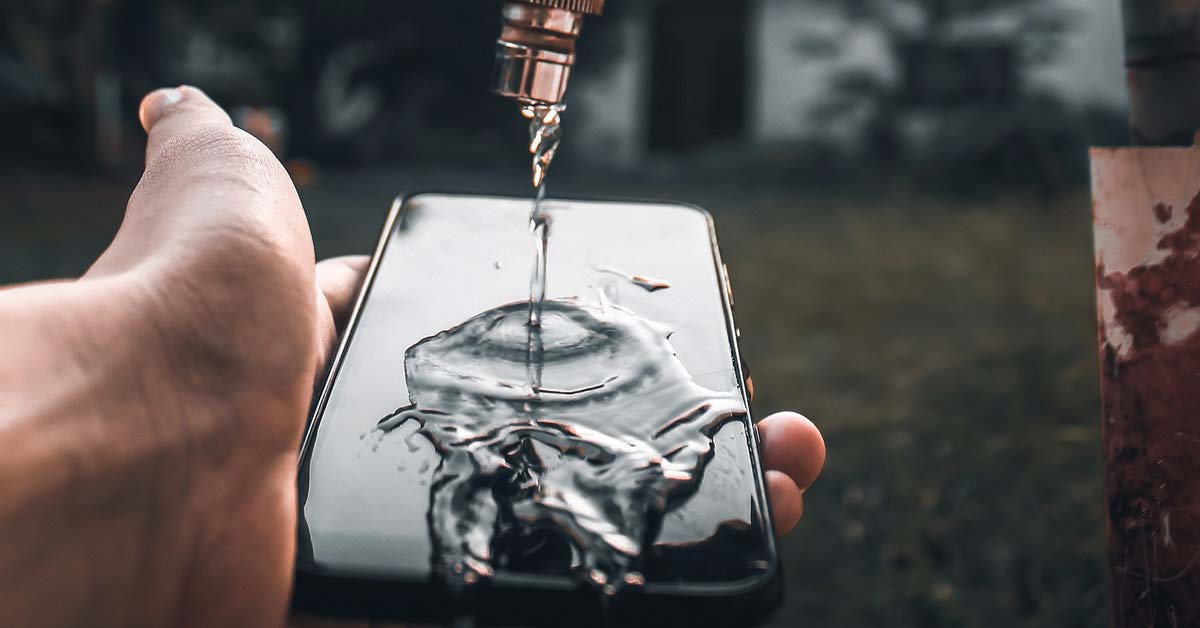No matter how careful we are, it seems that our cell phone has a mind of its own when it comes to falling into swimming pools, pots of water and even toilets! Plus, if you get caught in a heavy rainstorm or even use your cell phone with a wet hand, it usually doesn't take long for those water droplets to get under your phone's screen.
So exactly how does waterproof cell phone work? Understand more in this article!

How does a waterproof cell phone work?
First of all, understand that, technically, few phones are 100% waterproof — most are simply water resistant. Manufacturers achieve water resistance by using a powerful glue to cement the phone's external components together. Additionally, they typically use rubber gaskets around ports and removable components, and small silicone boots around buttons.
However, phones generally cannot be fully sealed, as this can lead to problems with air pressure differences between the inside and outside of the device. Additionally — speakers and microphones are not completely sealed as they require air to produce vibrations. Instead, manufacturers cover them with pieces of very fine mesh or a breathable membrane that repels water and allows it to pass over them.
Manufacturers indicate in their product specifications how water resistant a phone is using the second digit in an Ingress Protection rating. For example, 0 represents a complete lack of water resistance, 3 represents resistance to water spray, and 8 represents water resistance to a depth of up to nine meters for a period specified by the manufacturer.
What can you do with a waterproof cell phone?
It's critical to understand that most phone manufacturers don't cover water damage in their warranties — even when devices are classified as water-resistant or cell phone waterproof.
That said, you can expect your phone to withstand liquid according to its rating — whether it's a powerful jet of water at a car wash or full submersion in a pool. However, it is wise not to cause this type of condition voluntarily.
Cell phone Water resistant, but not invincible
Water resistance is often confused with waterproofing, but the two terms are definitely not synonymous. The latter implies complete protection, while resistance suggests some level of vulnerability and certainly not complete coverage. There are varying degrees of water resistance, with some devices offering substantially more protection than others. Unlike a waterproof material that has specific waterproof properties, a water-resistant device only has a tightly sealed barrier that protects the delicate circuitry inside. Unfortunately, if the barrier fails, your device will no longer be water resistant.
A small splash or even a quick dip in fresh water might not pose any problem for a phone with the proper water resistance rating, but that situation quickly changes when we start moving into the real world. For example, chlorinated or salt water can attack and corrode the gaskets and rubber seals that protect your device from water.
Over time, they can weaken, leaving your phone exposed to moisture damage. The same goes for coffee, soda spills or champagne, most phones have not been fully tested with these types of liquids.
TOP10 Waterproof cell phone
It's fair to assume that electronics and water aren't the best of friends, but in recent years the idea of a phone falling into a body of water isn't necessarily a death sentence anymore.
Manufacturers have been exploring ways to make their products more resistant to dirt, shock, extreme temperatures and humidity for years, and today there are established methods that help ensure this technology is more resilient.
Originally, you had to look at the names of manufacturers specializing in phone cases to get the protection you needed from the elements for your cell phone; adding bulk to your sleek, lightweight designs and complicating access to ports and controls in the process.
More recently, phones – particularly those in the main space – have benefited from internal design changes and additions that help make them sturdier without affecting their overall dimensions or aesthetics. Check out the 10 best waterproof cell phones below:
1. iPhone 13 Pro
Pros: Bright screen | Powerful cameras | Top-notch performance | Longer battery life
Cons: Cinematic Mode and HDR algorithm need tweaking | Dear
2. iPhone 12
Pros: Beautiful design | Great screen | Excellent performance | Solid cameras
Cons: No high refresh rate display | Dear
3. iPhone 11 and Pro Max
Pros: Good software support | Solid battery | Great cameras
Cons: No 5G | Aged Hardware
4. Google Pixel 6
Pros: 120Hz screen | Powerful cameras | Greatly improved battery life
Cons: Biggest, thickest and heaviest pixel yet | Strange loading
5. Samsung Galaxy S21
Pros: Beautiful 120Hz screen | Compact Design (S21) | Strong performance
Cons: Some downgrades compared to the S20
6. Oppo Find X3
Pros: Best-in-class screen | Excellent battery life | Great rear cameras
Cons: Poor battery life
7. Xiaomi Mi 11
Pros: Exceptional hardware | Impressive screen | Super fast charging
Cons: Ugly camera module | Poor long-term update support
8. Asus Zenfone 8
Pros: Good small Android phone | 120Hz clear screen | Great performance
Cons: Lower than expected battery life
9. One Plus 9 Pro
Pros: Beautiful design | Beautiful 120Hz screen | Excellent performance | Fast wired and wireless charging
Cons: Night photos are inconsistent
10. Samsung Note 20
Pros: 6.9-inch 120Hz dynamic display | Smoother S-pen performance | Powerful 50x zoom camera and laser autofocus | Very good battery life
Cons: Expensive
How to take care of your waterproof cell phone?
The waterproof cell phone is designed to be more resilient than your standard gadgets. However, they are not invincible and users should take extra care of their device after putting them in some more unforgiving environments.
Here is a list of simple tips that will keep your water-resistant smartphone in tip-top condition so it can withstand a few drops throughout its lifespan.
- Make sure all entrances are closed before taking your phone into the water. This includes SIM and microSD card slots, as well as the USB port cover if your phone has them.
- Wash your phone with fresh water after swimming, just to make sure any chlorinated water is removed. But don't use soap or chemicals.
- Avoid salt water and extreme conditions such as high heat or rugged environments.
- Dry the device thoroughly before connecting other devices to the USB ports or headphone. The phone is failsafe, but you wouldn't want to fry anything with a short circuit. You can use a dry microfiber cloth if your phone isn't drying quickly enough.
- Avoid hot temperatures. You don't need your phone in a sauna, relax. Also don't try to dry it with a hairdryer, just use a cloth.
- Remove dirt, hair or any other small objects from the ports. Plugging something into a port that has dirt on it is a good way to ruin the connectors, and even small particles can cause damage to the port's seals. microSD card.
With these tips and some good general care, your waterproof phone should have no trouble doing exactly what its rating suggests it's capable of. Remember they are phones first, don't treat them like bath toys.
